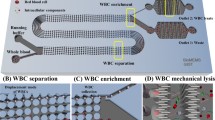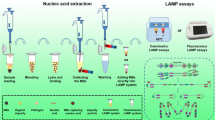Abstract
Finding a suitable DNA purification system is vital for the success of many PCR based diagnostic tests. This report demonstrates the value of magnetic beads in combination with real-time PCR for the sequence-specific isolation and detection of episomal HPV16 DNA. In order to maximize the isolation, two purification procedures were evaluated. Compared to the indirect method, in which the target was magnetically labeled after being hybridized to the capture probes, much higher efficiencies were obtained by directly capturing the target using DNA functionalized beads. These higher efficiencies were obtained by carefully tuning the capture probe density on the beads. When modifying the beads with dual-biotinylated capture probes or introducing beads modified with different capture probes, the amount of HPV16 isolated from spiked clinical swab samples even increased further. This not only resulted in the use of dual-biotinylated capture probes in higher purification efficiencies, but also the thermostability of the DNA-bead linkage was found to improve. In summary, this study shows that DNA functionalized magnetic beads are very promising diagnostic tools as they allow for a specific, simple, and fast isolation and concentration of minute quantities of DNA from complex clinical samples.






Similar content being viewed by others
References
Schiffman M, Castle PE, Jeronimo J, Rodriguez AC, Wacholder S (2007) Human papillomavirus and cervical cancer. Lancet 370:890–907
Bosch FX, de Sanjosé S (2002) Human papillomavirus in cervical cancer. Curr Oncol Rep 4:175–183
Munoz N, Bosch FX, de Sanjose S, Herrero R, Castellsague X, Shah KV, Snijders PJ, Meijer CJ (2003) Epidemiologic classification of human papillomavirus types associated with cervical cancer. N Engl J Med 348:518–527
Peyton CL, Schiffman M, Lorincz AT, Hunt WC, Mielzynska I, Bratti C, Eaton S, Hildesheim A, Morera LA, Rodriguez AC, Herrero R, Sherman ME, Wheeler CM (1998) Comparison of PCR- and hybrid capture-based human papillomavirus detection systems using multiple cervical specimen collection strategies. J Clin Microbiol 36:3248–3254
Sandri MT, Lentati P, Benini E, Dell'Orto P, Zorzino L, Carozzi FM, Maisonneuve P, Passerini R, Salvatici M, Casadio C, Boveri S, Sideri M (2006) Comparison of the Digene HC2 assay and the Roche AMPLICOR human papillomavirus (HPV) test for detection of high-risk HPV genotypes in cervical samples. J Clin Microbiol 44:2141–2146
Stevens MP, Garland SM, Rudland E, Tan J, Quinn MA, Tabrizi SN (2007) Comparison of the digene hybrid capture 2 assay and Roche AMPLICOR and LINEAR ARRAY human papillomavirus (HPV) tests in detecting high-risk HPV genotypes in specimens from women with previous abnormal Pap smear results. J Clin Microbiol 45:2130–2137
Li J, Lee JY, Yeung ES (2006) Quantitative screening of single copies of human papilloma viral DNA without amplification. Anal Chem 78:6490–6496
Roberts I, Ng G, Foster N, Stanley M, Herdman MT, Pett MR, Teschendorff A, Coleman N (2008) Critical evaluation of HPV16 gene copy number quantification by SYBR green PCR. BMC Biotechnol 8:57
Burd EM (2003) Human papillomavirus and cervical cancer. Clin Microbiol Rev 16:1–17
Josefsson AM, Magnusson PK, Ylitalo N, Sorensen P, Qwarforth-Tubbin P, Andersen PK, Melbye M, Adami HO, Gyllensten UB (2000) Viral load of human papilloma virus 16 as a determinant for development of cervical carcinoma in situ: a nested case-control study. Lancet 355:2189–2193
van Duin M, Snijders PJ, Schrijnemakers HF, Voorhorst FJ, Rozendaal L, Nobbenhuis MA, van den Brule AJ, Verheijen RH, Helmerhorst TJ, Meijer CJ (2002) Human papillomavirus 16 load in normal and abnormal cervical scrapes: an indicator of CIN II/III and viral clearance. Int J Cancer 98:590–595
Walboomers JM, Jacobs MV, Manos MM, Bosch FX, Kummer JA, Shah KV, Snijders PJ, Peto J, Meijer CJ, Munoz N (1999) Human papillomavirus is a necessary cause of invasive cervical cancer worldwide. J Pathol 189:12–19
Berensmeier S (2006) Magnetic particles for the separation and purification of nucleic acids. Appl Microbiol Biotechnol 73:495–504
Safarik I, Safarikova M (2004) Magnetic techniques for the isolation and purification of proteins and peptides. Biomagn Res Technol 2:7
Archer MJ, Lin B, Wang Z, Stenger DA (2006) Magnetic bead-based solid phase for selective extraction of genomic DNA. Anal Biochem 355:285–297
Parham NJ, Picard FJ, Peytavi R, Gagnon M, Seyrig G, Gagne PA, Boissinot M, Bergeron MG (2007) Specific magnetic bead based capture of genomic DNA from clinical samples: application to the detection of group B streptococci in vaginal/anal swabs. Clin Chem 53:1570–1576
Zhao X, Tapec-Dytioco R, Wang K, Tan W (2003) Collection of trace amounts of DNA/mRNA molecules using genomagnetic nanocapturers. Anal Chem 75:3144–3151
Choi JW, Oh KW, Thomas JH, Heineman WR, Halsall HB, Nevin JH, Helmicki AJ, Henderson HT, Ahn CH (2002) An integrated microfluidic biochemical detection system for protein analysis with magnetic bead-based sampling capabilities. Lab Chip 2:27–30
Yeung SW, Hsing IM (2006) Manipulation and extraction of genomic DNA from cell lysate by functionalized magnetic particles for lab on a chip applications. Biosens Bioelectron 21:989–997
Coutlee F, Gravitt P, Kornegay J, Hankins C, Richardson H, Lapointe N, Voyer H, Franco E (2002) Use of PGMY primers in L1 consensus PCR improves detection of human papillomavirus DNA in genital samples. J Clin Microbiol 40:902–907
Harnish DG, Belland LM, Scheid EE, Rohan TE (1999) Evaluation of human papillomavirus-consensus primers for HPV detection by the polymerase chain reaction. Mol Cell Probes 13:9–21
Karlsen F, Kalantari M, Jenkins A, Pettersen E, Kristensen G, Holm R, Johansson B, Hagmar B (1996) Use of multiple PCR primer sets for optimal detection of human papillomavirus. J Clin Microbiol 34:2095–2100
Nazarenko I, Kobayashi L, Giles J, Fishman C, Chen G, Lorincz A (2008) A novel method of HPV genotyping using hybrid capture sample preparation method combined with GP5+/6+ PCR and multiplex detection on Luminex XMAP. J Virol Methods 154:76–81
Peeters S, Stakenborg T, Colle F, Liu C, Lagae L, Van RM (2010) Real-time PCR to study the sequence specific magnetic purification of DNA. Biotechnol Prog 26:1678–1684
Rector A, Tachezy R, Van RM (2004) A sequence-independent strategy for detection and cloning of circular DNA virus genomes by using multiply primed rolling-circle amplification. J Virol 78:4993–4998
Stanley MA, Browne HM, Appleby M, Minson AC (1989) Properties of a non-tumorigenic human cervical keratinocyte cell line. Int J Cancer 43:672–676
Barken KB, Gabig-Ciminska M, Holmgren A, Molin S (2004) Effect of unlabeled helper probes on detection of an RNA target by bead-based sandwich hybridization. Biotechniques 36:124–132
Fuchs BM, Glockner FO, Wulf J, Amann R (2000) Unlabeled helper oligonucleotides increase the in situ accessibility to 16S rRNA of fluorescently labeled oligonucleotide probes. Appl Environ Microbiol 66:3603–3607
Acknowledgments
The authors would like to thank all members of the FNS research group for their valuable scientific input. Sara Peeters is grateful to the Institute for the Promotion and Innovation through Science and Technology (IWT-Vlaanderen).
Author information
Authors and Affiliations
Corresponding author
Electronic supplementary material
Below is the link to the electronic supplementary material.
ESM 1
(DOCX 264 kb)
Rights and permissions
About this article
Cite this article
Peeters, S., Stakenborg, T., Colle, F. et al. Specific magnetic isolation for direct detection of HPV16. Eur J Clin Microbiol Infect Dis 31, 539–546 (2012). https://doi.org/10.1007/s10096-011-1345-4
Received:
Accepted:
Published:
Issue Date:
DOI: https://doi.org/10.1007/s10096-011-1345-4




